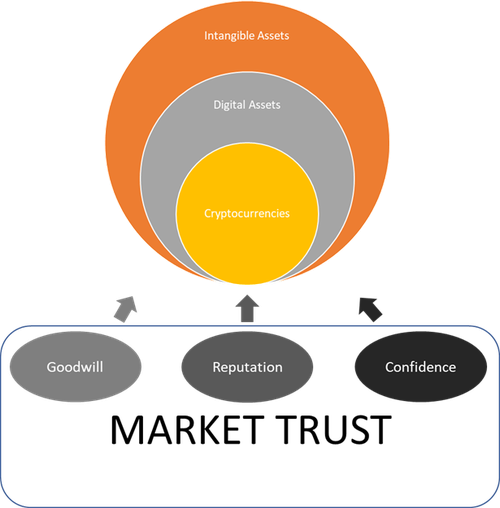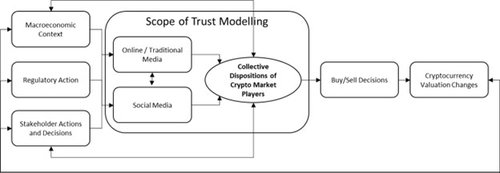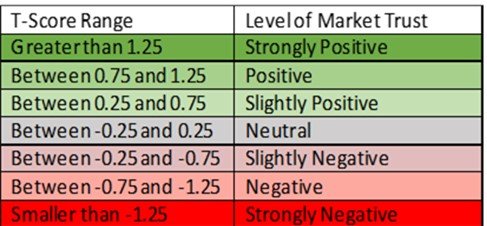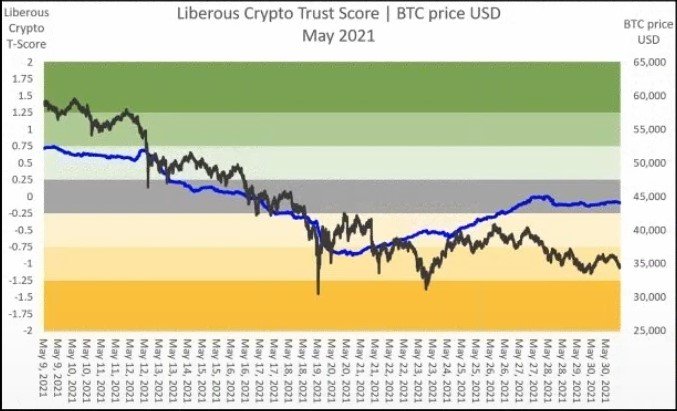Gauging Crypto Market Trust With Liberous
Monday, 17 October 2022By Arik Brutian
For access to Liberous, login to the FS Clubroom.
Could you think about an asset class that can have a 1000% growth/decline rate within years? Cryptocurrencies have had a roller coaster drive over the past decade - with their roots being an obscure “crypto punk” projects of late 1990s, they have gained a momentum in late 2009 with Bitcoin and its followers, reaching high peaks and then sliding down into the abyss in late 2010s and early 2020s. No asset class in history, arguably, has had such a drive within a mere decade.
All over this time, the key mystery has been cryptocurrency valuation; indeed, what could possibly determine the value of an asset that lacks physical essence and institutional support, has not really become a mainstream medium of exchange, does not act as a unit of account, or is not (at least yet) a debt or equity asset? Why would in the middle of the “Second Crypto Winter”, global exchanges and investment banks start opening digital asset practices, obviously betting on intrinsic value to crypto currencies?
Answers to these questions will determine the ultimate winners and losers of the cryptocurrency game. These answers all boil down what determines the valuation of cryptocurrencies.
One possible answer that seems to have worked (at least by now) is surprisingly simple: cryptocurrencies are digital assets; by entailment, they are intangible assets. And the value of intangible assets is determined by goodwill and confidence that the assets key stakeholders have towards it, as well as the reputation of these assets. So if there is a common cause of goodwill, confidence, and reputation, then therein lies the secret to cryptocurrency valuation.
But what is this common cause of goodwill, confidence, and reputation? The answer is - it is the trust that stakeholders have towards an intangible asset. Therefore, one can argue, the valuation of cryptocurrencies is (to a big extent) determined by the dynamic trust that the market, as the collective representation of stakeholder views and actions, has towards them.

So now our challenge will be to measure market trust into a given cryptocurrency, thus measuring its valuation. But this is easier said than done - trust is hardly quantifiable. How does one measure the unmeasurable?
The Liberous answer is rather simple - instead of measuring trust into a given asset, Liberous models the process of trust formation, thus allowing to assess the direction in which trust will be changing, and the result of this modelling process provides with insights into the market trust.
How does modelling work? Think about a one-time password (OTP) authentication app that you probably have in your phone in order to assess your private data: the OTP algorithm works by symmetric generation of passwords in your phone and in the application (email, e-banking) that you want to login to. A complex mathematical process with unique parameters happens in both apps, so when you check the output of that process at any moment, it is the same in both apps - hence, the ability so prove the right to assess your data.
Liberous uses the same logic - the process of formation of trust towards key cryptocurrencies is carefully algorithmically modelled, based on the same parameters, that define trust formation in real world. Thus, the strength of trust, as well as its directionality, can be checked by measuring the output of the algorithm. Of course, the precision of this modelling is not as absolute as with mathematical operations behind the OTP algorithm (since modelling trust involves more unknowns than prime factorization of large numbers), but it is sufficient to provide with relative trust value and directionality of trust; by entailment, this implies providing with a signal on relative valuation of a cryptocurrency, as well as an insight into directionality of its change.
But how does modelling of trust work? In order to answer this question, we need to step back and understand how trust appears in the real word. Trust is a dynamic, ever-changing perceptual construct; it appears as a result of mediated observation of an asset performance, mainly through media and/or social media. Shared collective perceptions of market participants thus formed are what we refer to as “trust”. Since trust is a shared perception, its previous history matters: trust of the past determines that of today. So by modelling how trust is being continuously shaped and reshaped amongst those, whose decisions matter (market players), we can access its level and directionality at any moment.
And that is precisely what Liberous does, as the visual above shows. All events, actions, and contexts that create or undermine trust into a given crypto reach market players through online/traditional and/or social media. Crypto market players’s shared collective perceptions form trust, which results in buy/sell decisions and in subsequent crypto valuation change. And the cycle iterates. Liberous models precisely the trust formation part of the process.

How does that happen? Liberous has selected the sources (news, regulator publications, influential blogs, social media) that are the regular channels of information for crypto market players. All sources are monitored in real time, and all relevant publications are immediately parsed and analyzed, using proprietary AI technology. The output of analysis becomes an input into the Trust algorithm, that works in real time, modelling the current level of trust for all key cryptocurrencies. The algorithm produces a Trust score (T-score) and a Trust outlook, providing with forward-looking signals about cryptocurrency valuation. Liberous T-score has shown a 0.83 directional correlation with the change in main crypto scores, with strong Granger Causality showing that trust indeed plays an important role in determining the future valuation of cryptocurrencies.
The T-score with all underlying data is available for FS Club Members: the Dashboard tab shows the T-score value and the change outlook for 13 key cryptocurrencies; it also shows the percentage change for the last 24 hours. Time series for cryptos are also displayed.
T-score ranges from 2 and negative 2, separated into increments of 0.5, with each representing a different outlook, as illustrated in the chart.

The Analysis page displays detailed trust-related data, allowing to make immediate decisions. One can choose a crypto and see the T-score for the past week, the publication count, the topic count, as well as the bar charts representing sentiment of a given crypto coverage (negative/neutral/positive). At any of the datapoints, a user can just click through and see the list of all publications (with the links to the original stories) that have affected the T-score. For example, if one selects BTC and hits “negative” value for the sentiment, all the negative articles for BTC published during the past seven days will be listed. Thus, Liberous also acts as a media/information monitoring service for cryptocurrencies.
Liberous is very careful about “sentiment”; if almost any other information service sees sentiment as an ultimate predictive signal or indicator, for Liberous sentiment is but only one of the inputs into the trust model. Sentiment is static, short term, and, by itself, non-informative, while trust is dynamic, contextual, and meaningful, as the table below displays:
| SENTIMENT | TRUST |
|---|---|
| Static snapshot of general abstract mood | Dynamic model of relevant stakeholder views |
| General measure of how media present a crypto at a given moment | Cumulative perception of crypto performance and outlook |
| Measures the output - media agenda, which may or may not influence public agenda | Assesses the outgrowth - public agenda that influences decisions; is a valid predictor of valuation changes |
| Contained in the news; has no predictive power over stakeholder actions | Emerges through the interaction of a stakeholder with a crypto-related information; this interaction is what Liberous models |
| Short-term, emerges and re-emerges with every new publication, without continuity with previous information coverage | Long-term, and historical, builds over time and requires multiple interactions |
| Absolute and out-of-context, sentiment for every crypto does not depend on the sentiment for others | Comparative and contextual; trust of any crypto considers the level of trust to other cryptos |
A historical example of Liberous’ ability to successfully model and track price changes can be seen in May of 2021. On the 12th of May, Elon Musk tweeted that Tesla would no longer be accepting Bitcoin as payment due to concerns over its excessive energy consumption. Reflecting this downturn in sentiment towards bitcoin, Liberous’ Bitcoin T-score declined from 12th May, turning negative on the 17th May. During the month of May, the correlation coefficient between T-score and price was measured to be 0.83, and the T-score can be seen predicting the movement of bitcoin price. The greater price trends were clearly rooted in the varying levels of trust market participants had in Bitcoin.

Liberous is available not only in the FS Clubroom, but also at www.liberous.com, on desktop app, mobile app, and through an API.